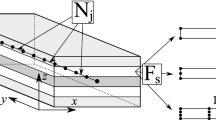An analysis of known schemes of specimens for testing fillers of multilayered structures in shear to determine their stiffness and strength characteristics is presented. Based on results of a numerical simulation of the stress–strain state formed in the filler of test specimens in shear experiments, a refined scheme of their design, fastening, and loading is suggested, which ensures the realization of practically zero transverse compressive stresses and a constant tangential stress along the filler length (except for the short zones of edge effects). A computational-experimental method for determining the stiffness and strength characteristics of the fillers in shear is offered, which is based on a synthesis and combined use of data of physical experiment and results of computational simulations.











Similar content being viewed by others
References
V. E. Bersudskii, V. N. Krysin, and S. I. Lesnykh, Manufacturing Technology of Honeycomb Aviation Structures, Mashinostroenie, Moscow (1975).
V. F. Panin and J. A. Gladkov, Structures with a Filler. Handbook, Mashinostroenie, Moscow (1991).
J. L. Grenestedt, “Effective elastic behavior of some models for ‘perfect’ cellular solids,” Int. J. Solid. Struct., No. 36, 1471–1501 (1999).
B. Lascoup, Z. Aboura, K. Khellil, and M. Benzeggagh, “On the mechanical effect of stitch addition in a sandwich panel,” Compos. Sci. Technol., No. 66, 1385–1398 (2006).
Q. M. Li, R. A. W. Mines, and R. S. Birch, “The crush behavior of Rohacell-51WF structural foam,” Int. J. Solid. Struct., No. 37, 6321–6341 (2000).
D. J. O’Conner, “A comparison of test methods for shear properties of the cores of sandwich constructions,” J. Test. Evaluat., 17, No. 4, 241–246 (1989).
R. Garcia, T. A. Weisshaar, and R. R. McWithey, “An experimental and analytical investigation of the rail shear test method as applied to composite materials,” SESA Paper No. R79-105, Proc. 1979 SESA Spring Meeting, San Francisco, Calif., May 1979, Society of Experimental Stress Analysis (now, Society of Experimental Mechanics, SEM).
ASTM C273/C273M - 07a Standard Test Method for Shear Properties of Sandwich Core Materials (2000).
H. Toftegaard, “Initial fixture design for direct shear testing of sandwich core materials,” in: Risø (DK) (2006), pp. 337–347.
H. Toftegaard and S. Goutianos, “Composite skin elastic constants from monolithic in-plane specimens and bonded out-of-plane specimens,” J. Sandw. Struct. Mater., No. 9, 239–259 (2007).
V. V. Bolotin and Yu. N. Novichkov, Mechanics of Multilayered Structures [in Russian], Mashinostroenie, Moscow (1980).
V. N. Paimushin, “Nonlinear theory of moderate bending of three-layer shells with defects in the form of areas of adhesion failure,” Prikl. Mekh., 23, No. 11, 32–38 (1987).
V. N. Paimushin and S. N. Bobrov, “Refined geometric nonlinear theory of sandwich shells with a transversely soft core of medium thickness for investigation of mixed buckling forms,” Mech. Compos. Mater., 36, No. 1, 59–66 (2000).
M. B. Vakhitov, “Integrating matrices — a means for the numerical solution of differential equations of structural mechanics,” Izvest. Vuzov, Aviats. Tekhnika, No. 3, 50–61 (1996).
R. Z. Dautov and V. N. Paimushin, “On the method of integrating matrices in solving boundary-value problems for ordinary differential equations of the fourth order,” Izv. Vuzov. Matem., No. 10, 13–25 (1996).
A. V. Sachenkov, “Theoretical-experimental method for investigating the stability of plates and shells. Investigations into the theory of plates and shells,” Izdat. Kazan. Gos. Univer., Kazan’, Iss. 6-7, 391–433 (1970).
V. N. Paimushin, “Analytical-computational-experimental method for determining the critical loads and free frequencies of deformable solid bodies,” Dokl. Akad. Nauk SSSR, 330, No. 1, 51–54 (1993).
Author information
Authors and Affiliations
Corresponding author
Additional information
Translated from Mekhanika Kompozitnykh Materialov, Vol. 48, No. 4, pp. 521-538, July-August, 2012.
Rights and permissions
About this article
Cite this article
Paimushin, V.N., Zakirov, I.M., Lukankin, S.A. et al. Computational-experimental method to determine the averaged elastic and strength characteristics of fillers of multilayered structures in shear. Mech Compos Mater 48, 355–368 (2012). https://doi.org/10.1007/s11029-012-9293-3
Received:
Published:
Issue Date:
DOI: https://doi.org/10.1007/s11029-012-9293-3




